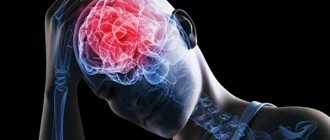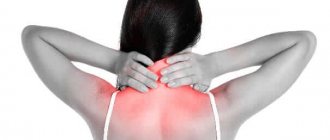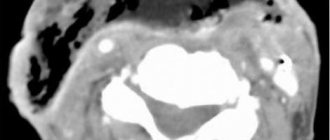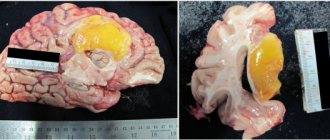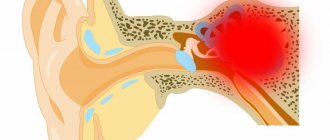Why is a pinched nerve in the lower back dangerous?
The pathology can develop at any age, but most often affects patients over 35 years of age.
A condition in which the lumbar nerve is pinched is fraught with various complications:
- muscle spasms;
- deterioration in coordination of movements;
- development of intervertebral hernia.
If a nerve is pinched, the immune defense is often weakened, and pathogenic viruses and bacteria easily enter the body. Other consequences of the pathology include sudden changes in blood pressure, dysfunction of internal organs, and the development of general weakness.
In the absence of quality therapy, the patient’s condition quickly deteriorates, accompanied by severe discomfort and loss of full performance.
Reasons why the sciatic nerve hurts
Sciatica (or, as it is also called, sciatic neuralgia) occurs due to the following diseases:
- Osteochondrosis of the lumbosacral spine. Pathological changes in the intervertebral discs cause a decrease in the distance between the vertebrae and lead to compression of the sciatic nerve;
- Intervertebral hernia of the lumbar region. In this case, compression of the sciatic nerve is caused by protrusion of the hernia towards the spinal canal;
- Spondylolisthesis. Instability of the spine in this disease leads to displacement of the vertebrae, and consequently to pinching of the sciatic nerve with the development of inflammatory processes;
- Dislocation or subluxation of the sacroiliac joint;
- Lumbar spinal canal stenosis. Excessive formation of soft tissue leads to a narrowing of the canal through which the spinal cord passes. All this leads to excessive pressure of the intervertebral discs on the nerve roots;
- Piriformis syndrome. The sciatic nerve passes under or through the piriformis muscle, which can cause irritation and inflammation.
Diagnosis of a pinched nerve root
After visiting a doctor with complaints of a pinched nerve, the following diagnostic procedures are performed:
- Examination of the patient.
- X-ray examination.
- Magnetic resonance imaging (MRI).
- Computed tomography (CT).
- Myelography.
- Electromyography.
The patient is also prescribed a general blood test and tests that indicate the presence or absence of affected nerves.
Based on the examination results, the specialist draws conclusions about the causes of the development of the pathology and begins to prescribe an adequate treatment course.
First aid for pinching
Sometimes it is necessary to alleviate the patient's condition urgently, before providing professional medical assistance. In such situations, perform the following actions:
- eliminate all factors that can worsen the patient’s well-being (drafts, cold, stress);
- lay the victim on a flat, hard mattress, provide him with complete rest;
- raise the lower limbs by placing several pillows under them;
- They tie the back tightly with a scarf (handkerchief) or put on a special corset.
If there is acute spasmodic pain, you can give the victim an analgesic. The approved drugs include Analgin, Paracetamol, Aspirin, Ketanov, Nise.
Clinical manifestations of sciatica
In most cases, one of the sciatic nerves is affected, so the pain is localized on one side, but damage to both nerves also occurs. When the sciatic nerve hurts, treatment is primarily aimed at reducing pain. They can be so strong that the patient cannot move not only the limbs, but also the torso, since each of them (including deep inhalations/exhalations) increases the pain. It has a shooting or burning character and radiates to the buttock and leg. In addition, the following clinical manifestations are observed:
- impaired skin sensitivity in the lumbar and gluteal regions, as well as legs;
- muscle weakness in the groin, lower extremities and fingers, paralysis;
- the patient is forced to take a position in which pain is reduced;
- attacks of pain occur due to stress, hypothermia, sudden movements;
- sexual disorders and fecal and urinary incontinence in the most severe cases.
Treatment for a pinched nerve in the lower back
When lower back compression occurs, treatment will consist of a variety of techniques. Specialists prescribe special medications, therapeutic exercises, manual therapy, and massage to patients.
In difficult cases, surgical intervention is required. Folk remedies are often given a supporting role.
Drug treatment
In order to eliminate negative symptoms and improve the patient’s condition, the following are prescribed:
- injections with drugs that relieve inflammation and pain (Movalis, Diclofenac, Ketonal, Novocaine);
- rubbing the lower back with ointments that have anti-inflammatory, warming, analgesic effects (Finalgon, Viprosal, Flexen, Betalgon).
Before prescribing certain medications, the specialist clarifies the degree of their tolerability. The duration of the medication course and dosage regimen are determined individually.
Physiotherapy
Therapeutic exercises are started after acute symptoms have been relieved. The most useful will be:
- Bend to the sides, forward.
- Walking in place with high knees.
- Swing your legs in different directions.
- Bend the legs at the knee joints, bringing them to the chest in a horizontal position.
- Riding on your back with your hands clasped around your knees.
- Twisting while lying on your side.
Training is carried out daily, for at least 10 minutes. The main goals of gymnastics are to improve blood circulation, absorption of nutrients, and activate the flow of oxygen to muscles and joints.
Manual therapy and massage
Manual therapy and massage methods can only be used as prescribed by a doctor. A manual specialist performs deep muscle work and has a pronounced effect on the lumbar spine.
The result of the doctor’s competent work is the unblocking of the existing pinching.
Massage provides a more superficial effect. This method relieves pain, improves blood and lymph circulation, and normalizes the function of the pathological nerve. Procedures performed by an experienced specialist help avoid unwanted relapse in the future.
Surgical intervention
The grounds for the operation are:
- insufficient effectiveness of conservative therapy;
- the patient has a hernia.
If the integrity of the nerve is compromised, the patient is prescribed neurosurgical intervention to restore damaged nerve threads.
This method is used in cases where the main treatment does not bring results for two or more months.
Impact with folk remedies
If a pinched nerve occurs in the lower back, treatment can be carried out using alternative medicine recipes. Traditional healers recommend using:
- Fresh celery juice (1 tablespoon inside, each time before meals). The method is also supplemented with compresses with herbal substances.
- Baths with medicinal plants (horse chestnut, oak bark, calamus root).
- Rubbing with fir oil or valerian tincture (after the procedure, the lower back is insulated with a woolen scarf or scarf).
- Honey cakes for the lumbar region.
Before starting home therapy, you must obtain your doctor’s approval and make sure you are not allergic to the components used.
Symptoms
The main symptom of a pinched sciatic nerve is pain. It begins in the buttocks and spreads along the back of the thigh all the way to the knee and ankle. Depending on the location and degree of pinching, the sensations can be sharp and sudden or aching that does not subside for a long time.
If the pinching occurs in the area of the spinal column or hip joint, the pain is aching in nature and intensifies when walking, squatting, or bringing the legs together.
When pinched in the piriform aperture, a person notes:
- dull pain over the entire surface of the thigh;
- a feeling of chilliness or burning of the skin in the affected area;
- decreased sensitivity in the back of the thigh and in the Achilles tendon area;
- sweating of the feet, feeling of heat in the toes.
If one of the large arteries passing through this area is pinched along with the nerve, the patient will experience a symptom of intermittent claudication. When walking for a long time, pain occurs in the leg, accompanied by numbness of the fingers and pale skin in this area. The sensations go away on their own with rest. Mild dysfunction of the pelvic organs often develops, in particular, a pause before urination.
Symptoms intensify when walking, as well as in a sitting position.
Kinesitherapy for pinched nerves in the lower back
A modern way to combat pathology is treatment at the Kinesitherapy Center.
The method is based on the principle of S. M. Bubnovsky. Kinesitherapy involves performing alternative gymnastics exercises and using a simulator that has both decompression and antigravity.
If you are concerned about pinching in the lower back, you should entrust the symptoms and treatment of the pathology to our specialists.
Regular training under the supervision of qualified employees will provide a lot of positive effects: they will remove pain, improve blood circulation, normalize motor activity and range of motion in the joints.
The kinesitherapy method guarantees an increase in the quality of life and restoration of working capacity. Our Centers operate in Zelenograd, Tver, Dubna and Klin.
If there is a pinched nerve in the lower back, pain, treatment must begin as soon as possible. Delay can cause dangerous complications and cause a deterioration in overall health.
Causes
The main cause of back pain is the presence of degenerative diseases of the spinal column. Thus, with osteochondrosis or osteoporosis, the metabolism in the body is disrupted, the lumen of the intervertebral discs decreases, and the vertebrae are compressed by the nervous tissue. The main causes of infringement of the spinal roots include the following phenomena:
Acute back pain
- curvature of the spinal column, when the bend of the vertebrae reaches 45 degrees or more;
- injuries, cracks and fractures of bone tissue;
- impaired metabolism in the body (this condition is typical for diabetics and pregnant women);
- heavy loads on the body and excessive passion for physical education;
- intervertebral hernias and protrusions;
- congenital anomalies of the spine;
- postoperative conditions;
- benign and malignant tumors of an oncological nature;
- sudden movement of the body or an unsuccessful fall.
If you are overweight and pregnant, you should pay great attention to the health of the musculoskeletal system, since the first blow comes to the human spine
The cause of the disease can be menopause, pregnancy and obesity. During menopause, a woman experiences hormonal disruptions, which causes bone fragility to increase. These processes are interconnected, as they lead to metabolic disorders in bone tissue.
[node:field_similarlink]
MESSAGE FROM THE CHIEF DOCTOR:
Often, when examining a patient, doctors pay attention only to the bones, ligaments, and joints. At the same time, nothing is said about muscles
, the function of contraction of which plays a significant role in human life. Weakened muscles lead to thinning and deformed bones.
Unfortunately, common methods of therapy only aggravate the situation, leading to even more severe pain, muscle atrophy and a deterioration in the quality of life of patients.
Effective treatment is impossible to imagine without muscle restoration. Unique kinesitherapy technique
consists in a therapeutic effect, which implies, first of all, muscle activity during the methodical execution of a set of exercises on special simulators.
All exercises are performed by patients sitting or lying down, so there is no excessive stress on the joints and circulatory system, and our instructors-methodologists correct the technique of movements
and monitor the correct execution of actions.
Remember that diseases of the spine and joints are not a death sentence; if the patient wishes and the right approach to treatment, everything can be corrected!
Do stretching exercises
Gentle stretches can help relieve pressure on the nerves and relieve the symptoms of a pinched nerve. These exercises will ensure good blood circulation and relax stiff muscles, thereby aiding the healing process.
Stretching exercises can be done while sitting at your desk watching TV or during a few minutes of break at work.
• If you have a pinched nerve in your neck, slowly rotate your neck in a circular motion with your head clockwise and also in the opposite direction to stretch the pinched muscles. You can also slowly move your neck back and forth and from side to side.
• If there is a pinched nerve in your hand, rotate your hands and wrists clockwise and vice versa.
You can ask your doctor about other stretches that can increase circulation and mobility in the area of the pinched nerve.


